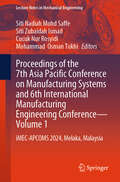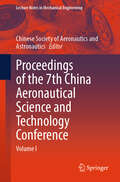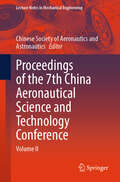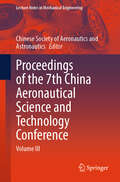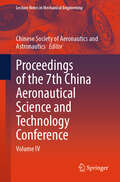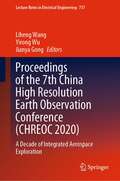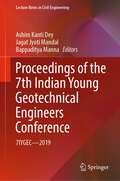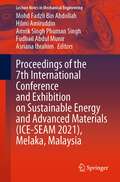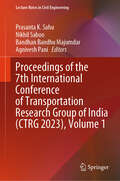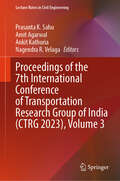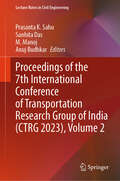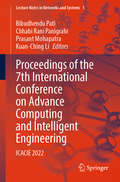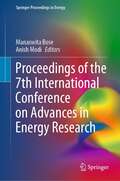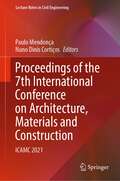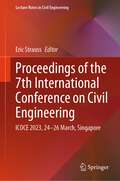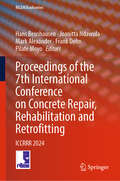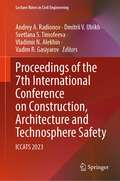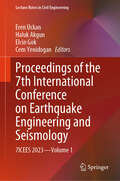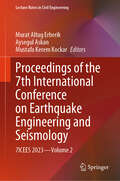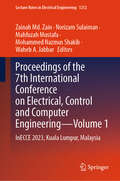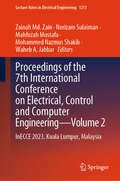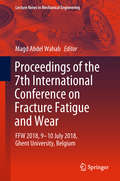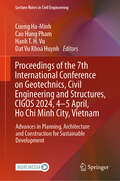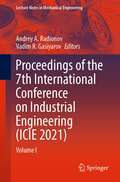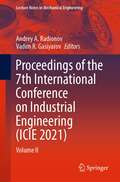- Table View
- List View
Proceedings of the 7th Asia Pacific Conference on Manufacturing Systems and 6th International Manufacturing Engineering Conference—Volume 1: iMEC-APCOMS 2024, Melaka, Malaysia (Lecture Notes in Mechanical Engineering)
by Mohammad Osman Tokhi Siti Zubaidah Ismail Siti Nadiah Mohd Saffe Cucuk Nur RosyidiThis publication showcases the 7th Asia-Pacific Conference on Manufacturing System and 6th International Manufacturing Engineering Conference (iMEC-APCOMS 2024) proceedings. It emphasizes the UN Sustainable Development Goals in recent developments and significant challenges in manufacturing industry, along with the emergence of intelligent manufacturing engineering and technology, which are critical for adopting Industry 4.0. The book discusses both traditional and advanced approaches used in various intelligent manufacturing applications. Readers can expect to gain a comprehensive understanding of current trends, challenges, solutions, and mitigating factors from this publication.
Proceedings of the 7th China Aeronautical Science and Technology Conference: Volume I (Lecture Notes in Mechanical Engineering)
by Chinese Society of Aeronautics and AstronauticsThis book contains the selected papers from the 7th China Aeronautical Science and Technology Conference. Topics include, but are not limited to: key technologies for aircraft (including fixed-wing, rotorcraft, new concept aircraft, etc.) design and overall optimization; aerodynamics; flight mechanics; structural design; advanced aviation materials (including composite materials); advanced aviation manufacturing; and design and overall optimisation; aerodynamics and flight mechanics; structural design; advanced aeronautical materials (including composite materials); advanced aeronautical manufacturing technology; advanced aeronautical propulsion technology; navigation, guidance and control technology; airborne systems, electromechanical technology; environmental control, life-saving technology; key technologies for multi-electric aircraft and all-electric aircraft; aviation testing technology; critical technologies in the vicinity of space vehicles; unmanned aerial vehicles and related technologies; general aviation flight safety, civil aviation transportation and air quality; aviation science and technology and industrial development policy and planning; other related technologies. Make this book a valuable resource for researchers, engineers and students.
Proceedings of the 7th China Aeronautical Science and Technology Conference: Volume II (Lecture Notes in Mechanical Engineering)
by Chinese Society of Aeronautics and AstronauticsThis book contains the selected papers from the 7th China Aeronautical Science and Technology Conference. Topics include, but are not limited to: key technologies for aircraft (including fixed-wing, rotorcraft, new concept aircraft, etc.) design and overall optimization; aerodynamics; flight mechanics; structural design; advanced aviation materials (including composite materials); advanced aviation manufacturing; and design and overall optimisation; aerodynamics and flight mechanics; structural design; advanced aeronautical materials (including composite materials); advanced aeronautical manufacturing technology; advanced aeronautical propulsion technology; navigation, guidance and control technology; airborne systems, electromechanical technology; environmental control, life-saving technology; key technologies for multi-electric aircraft and all-electric aircraft; aviation testing technology; critical technologies in the vicinity of space vehicles; unmanned aerial vehicles and related technologies; general aviation flight safety, civil aviation transportation and air quality; aviation science and technology and industrial development policy and planning; other related technologies. Make this book a valuable resource for researchers, engineers and students.
Proceedings of the 7th China Aeronautical Science and Technology Conference: Volume III (Lecture Notes in Mechanical Engineering)
by Chinese Society of Aeronautics and AstronauticsThis book contains the selected papers from the 7th China Aeronautical Science and Technology Conference. Topics include, but are not limited to: key technologies for aircraft (including fixed-wing, rotorcraft, new concept aircraft, etc.) design and overall optimization; aerodynamics; flight mechanics; structural design; advanced aviation materials (including composite materials); advanced aviation manufacturing; and design and overall optimisation; aerodynamics and flight mechanics; structural design; advanced aeronautical materials (including composite materials); advanced aeronautical manufacturing technology; advanced aeronautical propulsion technology; navigation, guidance and control technology; airborne systems, electromechanical technology; environmental control, life-saving technology; key technologies for multi-electric aircraft and all-electric aircraft; aviation testing technology; critical technologies in the vicinity of space vehicles; unmanned aerial vehicles and related technologies; general aviation flight safety, civil aviation transportation and air quality; aviation science and technology and industrial development policy and planning; other related technologies. Make this book a valuable resource for researchers, engineers and students.
Proceedings of the 7th China Aeronautical Science and Technology Conference: Volume IV (Lecture Notes in Mechanical Engineering)
by Chinese Society of Aeronautics and AstronauticsThis book contains the selected papers from the 7th China Aeronautical Science and Technology Conference. Topics include, but are not limited to: key technologies for aircraft (including fixed-wing, rotorcraft, new concept aircraft, etc.) design and overall optimization; aerodynamics; flight mechanics; structural design; advanced aviation materials (including composite materials); advanced aviation manufacturing; and design and overall optimisation; aerodynamics and flight mechanics; structural design; advanced aeronautical materials (including composite materials); advanced aeronautical manufacturing technology; advanced aeronautical propulsion technology; navigation, guidance and control technology; airborne systems, electromechanical technology; environmental control, life-saving technology; key technologies for multi-electric aircraft and all-electric aircraft; aviation testing technology; critical technologies in the vicinity of space vehicles; unmanned aerial vehicles and related technologies; general aviation flight safety, civil aviation transportation and air quality; aviation science and technology and industrial development policy and planning; other related technologies. Make this book a valuable resource for researchers, engineers and students.
Proceedings of the 7th China High Resolution Earth Observation Conference: A Decade of Integrated Aerospace Exploration (Lecture Notes in Electrical Engineering #757)
by Liheng Wang Yirong Wu Jianya GongThis book is the proceedings of the 7th China High-resolution Earth Observation Conference (CHREOC). The series conference of China High Resolution Earth Observation has become an influential academic event in the earth detection area, attracting more and more top experts and industry users of related fields. The CHREOCs focus on the popular topics including military-civilian integration, the One Belt and One Road project, the transformation of scientific research achievements. They also discuss the new ideas, new technologies, new methods, and new developments. The CHREOCs have effectively promoted high-level institutional mechanisms, technological innovation, and industrial upgrading in the high-resolution earth observation area, and extend the influences of the state-sponsored major projects.
Proceedings of the 7th Indian Young Geotechnical Engineers Conference: 7IYGEC - 2019 (Lecture Notes in Civil Engineering #195)
by Ashim Kanti Dey Jagat Jyoti Mandal Bappaditya MannaThis book comprises the select peer-reviewed papers presented at the 7th Indian Young Geotechnical Engineers Conference (7IYGEC 2019) held at the National Institute of Technology, Silchar. It covers recent research developments in geotechnical engineering particularly in the fields of shallow and deep foundations, rock mechanics, ground improvement techniques, geotechnical earthquake engineering, and characterization of soil. The book also discusses several computational techniques to model behavior of soil which can be useful for future research. A special emphasis is given on geo-environmental engineering for making the world cleaner and safer to live. Given the contents, the book will be beneficial for students, researchers, and professionals working in geotechnical engineering and allied areas.
Proceedings of the 7th International Conference and Exhibition on Sustainable Energy and Advanced Materials (Lecture Notes in Mechanical Engineering)
by Mohd Fadzli Bin Abdollah Hilmi Amiruddin Amrik Singh Phuman Singh Fudhail Abdul Munir Asriana IbrahimThis book gathers the proceedings of the 7th International Conference and Exhibition on Sustainable Energy and Advanced Materials (ICE-SEAM), held on November 2021, a virtual conference organized in Melaka, Malaysia. It focuses on two relatively broad areas—advanced materials and sustainable energy—and a diverse range of subtopics:Advanced materials and related technologies: liquid crystals, semiconductors, superconductors, optics, lasers, sensors, mesoporous materials, nanomaterials, smart ferrous materials, amorphous materials, crystalline materials, biomaterials, metamaterials, composites, polymers, design, analysis, development, manufacturing, processing and testing for advanced materials.Sustainable energy and related technologies: energy management, storage, conservation, industrial energy efficiency, energy-efficient buildings, energy-efficient traffic systems, energy distribution, energy modeling, hybrid and integrated energy systems, fossil energy, nuclear energy, bioenergy, biogas, biomass geothermal power, non-fossil energies, wind energy, hydropower, solar photovoltaic, fuel cells, electrification, and electrical power systems and controls.
Proceedings of the 7th International Conference of Transportation Research Group of India (Lecture Notes in Civil Engineering #417)
by Prasanta K. Sahu Nikhil Saboo Bandhan Bandhu Majumdar Agnivesh PaniThis book presents select proceedings of the 7th Conference of Transportation Research Group of India (7th CTRG, 2023) and provides an opportunity for discussion of state-of-the-art research and practice in the developing world for achieving equitable, efficient, and resilient infrastructure and opens pathways to sustainable transportation. This book covers the solutions related to transportation challenges such as road user safety, traffic operation efficiency, economic and social development, non-motorized transport planning, environmental impact mitigation, energy consumption reduction, land-use, equity, freight transport planning, multimodal coordination, access for the diverse range of mobility needs, sustainable pavement construction, and emerging vehicle technologies. The information and data-driven inferences compiled in this book are therefore expected to be useful for practitioners, policymakers, educators, researchers, and individual learners interested in sustainable transportation and allied fields.
Proceedings of the 7th International Conference of Transportation Research Group of India (Lecture Notes in Civil Engineering #422)
by Amit Agarwal Nagendra R. Velaga Prasanta K. Sahu Ankit KathuriaThis book presents select proceedings of the 7th Conference of Transportation Research Group of India (7th CTRG, 2023), provides an opportunity for discussion of state-of-the-art research and practice in the developing world for achieving equitable, efficient, and resilient infrastructure, and opens pathways to sustainable transportation. This book covers the solutions related to transportation challenges such as road user safety, traffic operation efficiency, economic and social development, non-motorized transport planning, environmental impact mitigation, energy consumption reduction, land-use, equity, freight transport planning, multimodal coordination, access for the diverse range of mobility needs, sustainable pavement construction, and emerging vehicle technologies. The information and data-driven inferences compiled in this book are therefore expected to be useful for practitioners, policymakers, educators, researchers, and individual learners interested in sustainable transportation and allied fields.
Proceedings of the 7th International Conference of Transportation Research Group of India (Lecture Notes in Civil Engineering #426)
by Prasanta K. Sahu M. Manoj Sanhita Das Anuj BudhkarThis book presents select proceedings of the 7th Conference of Transportation Research Group of India (7th CTRG, 2023) and provides an opportunity for discussion of state-of-the-art research and practice in the developing world for achieving equitable, efficient, and resilient infrastructure and opens pathways to sustainable transportation. This book covers the solutions related to transportation challenges such as road user safety, traffic operation efficiency, economic and social development, non-motorized transport planning, environmental impact mitigation, energy consumption reduction, land-use, equity, freight transport planning, multimodal coordination, access for the diverse range of mobility needs, sustainable pavement construction, and emerging vehicle technologies. The information and data-driven inferences compiled in this book are therefore expected to be useful for practitioners, policymakers, educators, researchers, and individual learners interested in sustainable transportation and allied fields.
Proceedings of the 7th International Conference on Advance Computing and Intelligent Engineering: ICACIE 2022 (Lecture Notes in Networks and Systems #1)
by Kuan-Ching Li Bibudhendu Pati Chhabi Rani Panigrahi Prasant MohapatraThis book gathers high-quality research papers presented at the 7th International Conference on Advanced Computing and Intelligent Engineering (ICACIE 2022) organized by the Department of Computer Science and Engineering, DRIEMS (Autonomous) Engineering College, Odisha, India, during December 23–24, 2022. It includes sections describing technical advances and the latest research in the fields of computing and intelligent engineering. Intended for graduate students and researchers working in the disciplines of computer science and engineering, the proceedings will also appeal to researchers in the field of electronics, as they cover hardware technologies and future communication technologies.
Proceedings of the 7th International Conference on Advances in Energy Research (Springer Proceedings in Energy)
by Manaswita Bose Anish ModiThis book presents selected papers from the 7th International Conference on Advances in Energy Research (ICAER 2019), providing a comprehensive coverage encompassing all fields and aspects of energy in terms of generation, storage, and distribution. Themes such as optimization of energy systems, energy efficiency, economics, management, and policy, and the interlinkages between energy and environment are included. The contents of this book will be of use to researchers and policy makers alike.
Proceedings of the 7th International Conference on Architecture, Materials and Construction: ICAMC 2021 (Lecture Notes in Civil Engineering #226)
by Paulo Mendonça Nuno Dinis CortiçosThis book gathers the proceedings of the 7th International Conference on Architecture, Materials and Construction (ICAMC), held in Lisbon, Portugal on October 27-29, 2021. ICAMC serves as an international forum for the presentation of the latest technological advances and research results in the fields of architecture and urban planning, civil and structural engineering, and materials manufacturing and processing. As such, it explores highly diverse topics, including innovative construction technologies (computer and digital manufacturing) and materials (polymers, composites, etc.); traditional materials (glass, wood, steel, concrete, stone, brick, etc.) and its harmonic combination which can be achieved by evaluating their structural and non-structural properties; the key concepts of efficiency and sustainability related to the architectural design and engineering of new buildings; analysis, rehabilitation and restoration of buildings. The contributions, which were selected by means of a rigorous international peer-review process, highlight numerous exciting ideas that will spur novel research directions and foster multidisciplinary collaborations.
Proceedings of the 7th International Conference on Civil Engineering: ICOCE 2023, 24–26 March, Singapore (Lecture Notes in Civil Engineering #371)
by Eric StraussThis book contains research papers presented at the 7th International Conference on Civil Engineering, which was held in Singapore from 24-26 March 2023. Significant results contained in the book show the importance of technology in solving engineering issues throughout the world. Highlighted topics include climate change, disaster relief, resilience, pollution control and management techniques for construction, mitigation and adaptation. Many techniques are utilized in a variety of contexts to solve engineering and urban management problems in both developed and developing countries. This volume consists of refereed submissions authored by a wide variety of international researchers and practitioners from many perspectives discussing emerging issues in civil and environmental engineering. Practical solutions to worldwide issues in hazard mitigation, pollution control, transportation infrastructure and energy production are emphasized. The chapters provide an in-depth look at current issues in these areas of engineering that should benefit interested individuals at all levels of expertise.
Proceedings of the 7th International Conference on Concrete Repair, Rehabilitation and Retrofitting: ICCRRR 2024 (RILEM Bookseries #59)
by Mark Alexander Hans Beushausen Frank Dehn Pilate Moyo Joanitta NdawulaThis book gathers contributions presented at the 7th International Conference on Concrete Repair, Rehabilitation and Retrofitting (ICCRRR), held in Cape Town, South Africa, on November 4–6, 2024. The conference aims at sharing knowledge and experience on current developments in concrete technology, durability design and service life management, condition assessment of concrete structures, and concrete repair, rehabilitation and retrofitting. The contributions, which were selected through a rigorous international peer-review process, share exciting ideas that will spur novel research directions and foster new multidisciplinary collaborations.
Proceedings of the 7th International Conference on Construction, Architecture and Technosphere Safety: ICCATS 2023 (Lecture Notes in Civil Engineering #400)
by Andrey A. Radionov Vadim R. Gasiyarov Dmitrii V. Ulrikh Svetlana S. Timofeeva Vladimir N. AlekhinThis book highlights recent findings in civil and environmental engineering and urban planning, and provides an overview of the state of the art in these fields, mainly in Russia and Eastern Europe. A broad range of topics and issues in modern engineering are discussed, including construction, buildings and structures, advanced materials, innovative technology, methods and techniques in civil engineering, heating, gas supply, water supply and sewerage, foundation engineering, BIM, structural reliability, durability and monitoring, special and unique structures construction (bridge, tunnel, road, railway engineering), design and construction of hydraulic structures, concrete engineering, urban regeneration and sustainable development, urban transport system, engineering structure safety and disaster prevention, water resources engineering, water and wastewater treatment, recycling and reuse of wastewater, etc. The volume gathers selected papers from the 7th International Conference on Construction, Architecture and Technosphere Safety (ICCATS), held in Sochi, Russia in September 2023. The authors are experts in various fields of engineering, and all papers have been carefully reviewed.
Proceedings of the 7th International Conference on Earthquake Engineering and Seismology: 7ICEES 2023—Volume 1 (Lecture Notes in Civil Engineering #488)
by Eren Uckan Haluk Akgun Elcin Gok Cem YenidoganThis volume gathers the proceedings of the 7th International Conference on Earthquake Engineering and Seismology (7ICEES), held in Antalya, Turkey on November 6-10, 2023, and affiliated with the 18th World Conference on Seismic Isolation (18WCSI). The conference discussed state-of-the-art information as well as emerging concepts and innovative applications related to earthquake engineering and seismology, in particular structural or non-structural risk mitigation tools for critical infrastructure. The contributions, which are published after a rigorous international peer-review process, highlight numerous exciting ideas that will spur novel research directions and foster multidisciplinary collaboration among different specialists.
Proceedings of the 7th International Conference on Earthquake Engineering and Seismology: 7ICEES 2023—Volume 2 (Lecture Notes in Civil Engineering #401)
by Murat Altug Erberik Aysegul Askan Mustafa Kerem KockarThis volume gathers the proceedings of the 7th International Conference on Earthquake Engineering and Seismology (7ICEES), held in Antalya, Turkey on November 6-10, 2023, and affiliated with the 18th World Conference on Seismic Isolation (18WCSI). The conference discussed state-of-the-art information as well as emerging concepts and innovative applications related to earthquake engineering and seismology, in particular structural or non-structural risk mitigation tools for critical infrastructure. The contributions, which are published after a rigorous international peer-review process, highlight numerous exciting ideas that will spur novel research directions and foster multidisciplinary collaboration among different specialists.
Proceedings of the 7th International Conference on Electrical, Control and Computer Engineering–Volume 1: InECCE 2023, Kuala Lumpur, Malaysia (Lecture Notes in Electrical Engineering #1212)
by Mahfuzah Mustafa Zainah Md. Zain Norizam Sulaiman Mohammed Nazmus Shakib Waheb A. JabbarThis book presents the proceedings of the 7th International Conference on Electrical, Control and Computer Engineering (InECCE 2023), held in Kuala Lumpur, Malaysia, on 22 August 2023. The topics covered are sustainable energy, power electronics and drives and power engineering including distributed/renewable generation, power system optimization, artificial/computational intelligence, smart grid, power system protection and machine learning energy management and conservation. The book showcases some of the latest technologies and applications developed to solve local energy and power problems in order to ensure continuity, reliability and security of electricity for future generations. It also links topics covered the Sustainable Development Goals (SDGs) areas outlined by the United Nation for global sustainability. The book appeals to professionals, scientists and researchers with experience in industry. The book represents Volume 1 for this conference proceedings, which consist of a 2-volume book series
Proceedings of the 7th International Conference on Electrical, Control and Computer Engineering—Volume 2: InECCE 2023, Kuala Lumpur, Malaysia (Lecture Notes in Electrical Engineering #1213)
by Mahfuzah Mustafa Zainah Md. Zain Norizam Sulaiman Mohammed Nazmus Shakib Waheb A. JabbarThis book presents the proceedings of the 7th International Conference on Electrical, Control and Computer Engineering (InECCE 2023), held in Kuala Lumpur, Malaysia, on 22 August 2023. The topics covered are sustainable energy, power electronics and drives and power engineering including distributed/renewable generation, power system optimization, artificial/computational intelligence, smart grid, power system protection and machine learning energy management and conservation. The book showcases some of the latest technologies and applications developed to solve local energy and power problems in order to ensure continuity, reliability and security of electricity for future generations. It also links topics covered the Sustainable Development Goals (SDGs) areas outlined by the United Nation for global sustainability. The book appeals to professionals, scientists and researchers with experience in industry. The book represents Volume 2 for this conference proceedings, which consist of a 2-volume book series
Proceedings of the 7th International Conference on Fracture Fatigue and Wear: FFW 2018, 9-10 July 2018, Ghent University, Belgium (Lecture Notes in Mechanical Engineering)
by Magd Abdel WahabThese proceedings gather a selection of peer-reviewed papers presented at the 7th International Conference on Fracture Fatigue and Wear (FFW 2018), held at Ghent University, Belgium on 9–10 July 2018.The contributions, prepared by international scientists and engineers, cover the latest advances in and innovative applications of fracture mechanics, fatigue of materials, tribology and wear of materials. The book is intended for academics, including graduate students and researchers, as well as industrial practitioners working in the areas of fracture fatigue and wear.
Proceedings of the 7th International Conference on Geotechnics, Civil Engineering and Structures, CIGOS 2024, 4-5 April, Ho Chi Minh City, Vietnam: Advances in Planning, Architecture and Construction for Sustainable Development (Lecture Notes in Civil Engineering #482)
by Cuong Ha-Minh Dat Vu Khoa Huynh Cao Hung Pham Hanh T. H. VuThis book includes peer-reviewed articles from the 7th International Conference on Geotechnics, Civil Engineering and Structures (CIGOS 2024) held on April 4-5 in Ho Chi Minh City, Vietnam. It highlights recent advances in planning, architecture, and construction for sustainable development. The book features a compilation of articles presented at the conference, bringing together researchers, academics, and practitioners from around the world. The topics covered range from Planning, Architecture, and Industrial Design to Construction, Materials, Structures, and Digital Technologies, as well as Geoscience, Environment, and Energy, and Transportation, Infrastructure, Management, and Investment. The book emphasizes the importance of a multidisciplinary approach to sustainable development in order to address environmental, social, and economic challenges faced by societies worldwide. It provides insights into best practices and innovative approaches for achieving sustainabledevelopment goals, such as reducing the carbon footprint, enhancing energy efficiency, promoting the use of eco-friendly materials, and implementing sustainable construction techniques. Overall, this book offers valuable knowledge and advice to professionals, researchers, and policymakers engaged in sustainable development initiatives.
Proceedings of the 7th International Conference on Industrial Engineering: Volume I (Lecture Notes in Mechanical Engineering)
by Andrey A. Radionov Vadim R. GasiyarovThis book highlights recent findings in industrial, manufacturing and mechanical engineering, and provides an overview of the state of the art in these fields, mainly in Russia and Eastern Europe. A broad range of topics and issues in modern engineering is discussed, including the dynamics of machines and working processes, friction, wear and lubrication in machines, surface transport and technological machines, manufacturing engineering of industrial facilities, materials engineering, metallurgy, control systems and their industrial applications, industrial mechatronics, automation and robotics. The book gathers selected papers presented at the 7th International Conference on Industrial Engineering (ICIE), held in Sochi, Russia, in May 2021. The authors are experts in various fields of engineering, and all papers have been carefully reviewed. Given its scope, the book will be of interest to a wide readership, including mechanical and production engineers, lecturers in engineering disciplines, and engineering graduates.
Proceedings of the 7th International Conference on Industrial Engineering: Volume II (Lecture Notes in Mechanical Engineering)
by Andrey A. Radionov Vadim R. GasiyarovThis book highlights recent findings in industrial, manufacturing and mechanical engineering, and provides an overview of the state of the art in these fields, mainly in Russia and Eastern Europe. A broad range of topics and issues in modern engineering is discussed, including the dynamics of machines and working processes, friction, wear and lubrication in machines, surface transport and technological machines, manufacturing engineering of industrial facilities, materials engineering, metallurgy, control systems and their industrial applications, industrial mechatronics, automation and robotics. The book gathers selected papers presented at the 7th International Conference on Industrial Engineering (ICIE), held in Sochi, Russia, in May 2021. The authors are experts in various fields of engineering, and all papers have been carefully reviewed. Given its scope, the book will be of interest to a wide readership, including mechanical and production engineers, lecturers in engineering disciplines, and engineering graduates.
